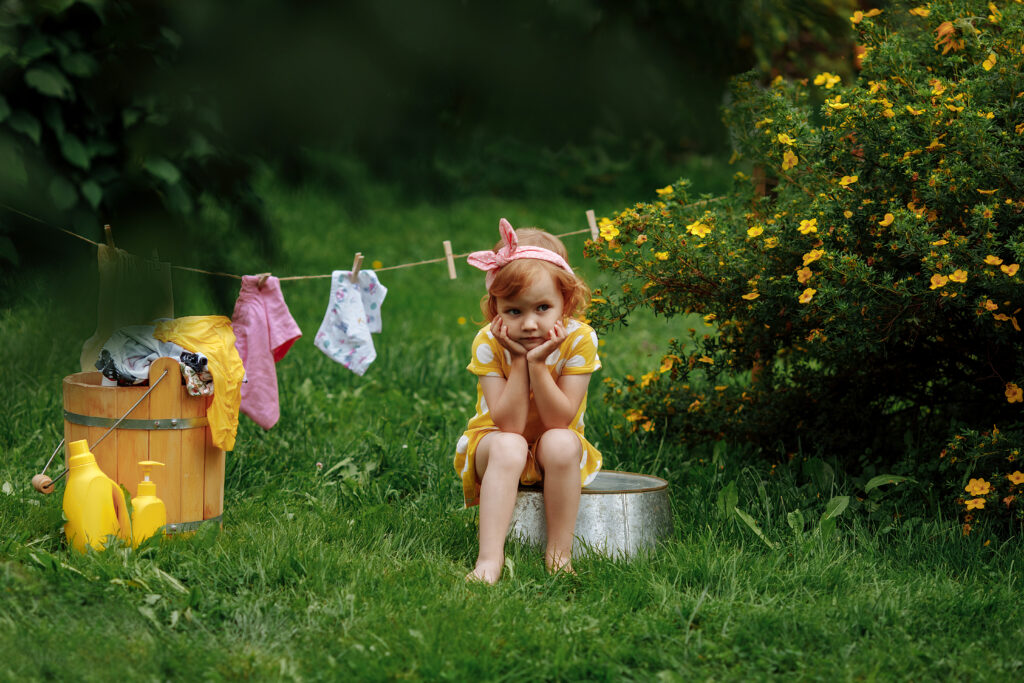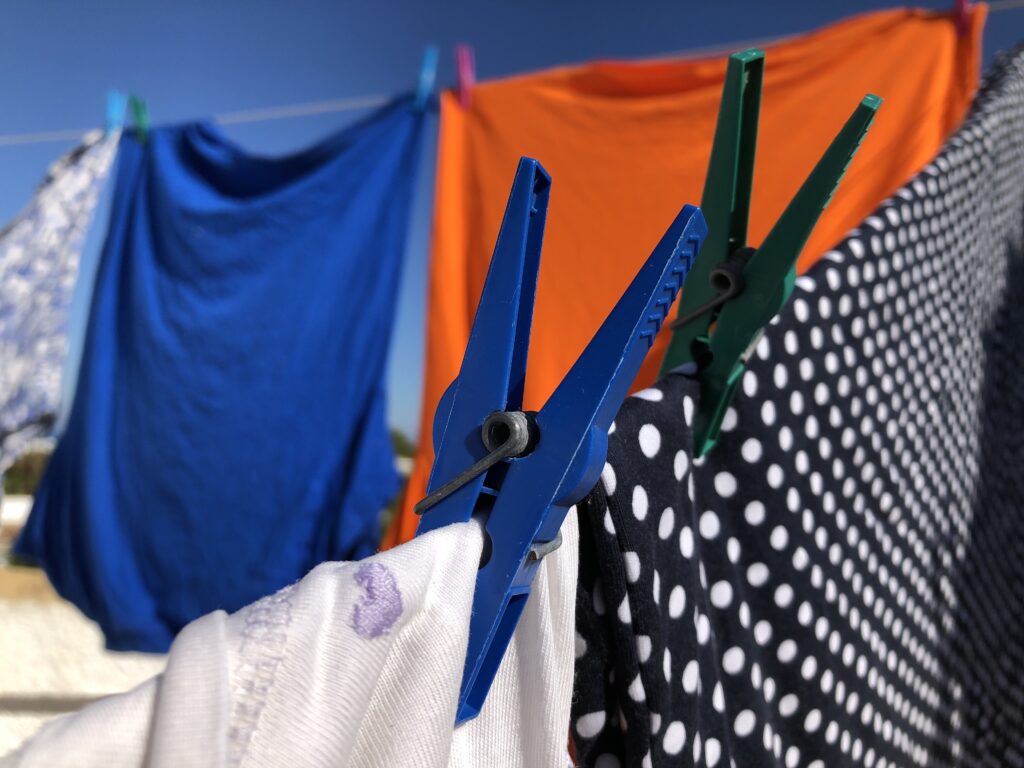We all love that feeling of wearing fresh and clean clothes, but it requires some proper care to protect their quality and make them last longer. We should know how to read symbols on labels on our clothes that show the best way to wash, dry, iron, bleach, and take care of them.
Some clothes in their labels have the symbol of a square with a curved line hanging downwards from the upper corners, which means that we must line dry laundry. That curved line inside the symbol represents a clothesline that is used to hang clothes. Another synonym for line dry is air drying.
The process of doing it is as simple as hanging them (drying rack or a clothesline) and letting them in the air to get dry over time. Airflow and higher temperatures make the water evaporate from clothes, resulting in dry clothes. Although it seems simple, there are some things you should consider learning about line drying before doing it.
Key Takeaways
- Line drying means you must hang your clothes on a clothesline or a drying rack to get them dry.
- You can get creative, choosing from different ways and options to do it.
- Fresh air during hot and dry days makes it perfect to line dry your clothes outside.
- When you can’t do it outside, there is always an option of doing it indoors, taking the proper measures.
- Line drying saves you money, is environmentally friendly, and makes you happier.
- Doing chores, including getting your clothes clean and fresh, takes a part of everybody’s daily life. Every small change you make doing these activities has a bigger effect than we sometimes can think of. So, there is always something we can learn and change to make our life easier and better.
How to Dry Line Your Clothes

How do you line dry your clothes?
The simplest way is to set up a clothesline by tying it between two distant points. It can be between two trees or two nails hammered into the wall if you have the proper space and materials to do so. The clothesline can be made from different materials: plastic-made, cotton, or nylon.
Plastic is easier to clean, and it’s waterproof, but it is thinner, and clothespins tend not to hold clothes, as well as on nylon or cotton lines. Cotton has a better grip. It is weaker but strong enough to hold drying clothes as they don’t weigh that much. Nylon is waterproof and strong, but it has less grip and is harder to tie. You can choose one of them considering these pros and cons, also considering the length of your clothesline and the type of pins or clips you use.
There are options to choose from for clothespins too. You can buy wooden, metal or plastic ones. Wooden pins have aesthetics but are not durable since they are prone to rotting when are in contact with water. Plastic ones are durable, but to someone may not be so aesthetically pleasing. Metal ones can be rustproof and durable, but they can be harsher on clothes.
It’s up to you to choose from these options. However, we would recommend using a cotton clothesline with plastic pins. Cotton clothesline has more grip, so it compensates for that less grip plastic pins offer since plastic pins are durable and don’t damage the fabric as much as metal ones.
Where should we line drying? Indoors or outdoors?
There are two most important factors that impact the time of line drying: temperature and humidity or moisture.
During summer days, when the sun is out, temperatures are high, and humidity is low, there are the best conditions to dry your clothes fast. However, we should consider the bleaching effect of the sun and not let colorful and black clothes be exposed to it as it fades them. During winter, you can line dry your clothes even though temperatures are low, as long as humidity is low too.
Indoor line drying clothes takes more time because you got less airflow. It also can get moisture levels up and create other problems like mold in the house. However, if you use some strategies and tricks, you can do it indoors too.
Some of these include: placing a drying clothesline or rack near heat sources, where there is airflow, and in places that are created to be protected from moisture, like bathrooms or kitchens. To make drying time quicker, you can also use a fan to make water molecules that evaporate from clothes diffuse in the air and get away from clothes.
In conclusion, the best way is to dry your clothes outside, but there are times when atmospheric conditions do not allow you to do it. There also may be a neighbor that is having a barbecue outside or running and playing with kids that can mess up your clean clothes. Keep in mind that with proper precautions, you always have the option to line drying indoors.
Which clothes are recommended to line dry?
You should check the labels on your clothes for the line dry symbol. Usually, synthetic fabrics are more sensitive to drying machines, so it is recommended to line drying them, as it makes them last longer. Fabrics with delicate parts such as lingerie are also prone to coming apart if dried in the machine.
White fabric is perfect to line dry outside as the sun is a natural whitener, and it also disinfects with its ultraviolet radiation. All clothes basically tend to last longer when line dried because the dryer tends to fade colors and wear down clothes over time.
What clothes are not recommended to line dry?
Knitted clothes, wool, and soft cotton fabrics are not candidates to line dry as they tend to stretch and lose their form if hanged. It is best if these fabrics lay flat as they are drying. Clothes with delicate parts also are not recommended to line dry outside on windy days.
What are the benefits of line drying?

Firstly, it saves you money. clothes dryer machine takes an initial expense buying and also makes the energy bill go up.
It is good for the environment. The more energy a household consumes, the residential output of carbon dioxide goes. With that said, ignoring the drying machine when you have a chance to line dry is good for you to save on energy expenses and also has a positive environmental impact.
As it was said earlier, it brightens and eliminates bacteria when it is done outside.
Makes clothes smell nice and fresh. Line drying in fresh air reduces any strong odors clothes may have. You also won’t need to use additional chemical laundry fresheners as it is enough chemistry surrounding us in our everyday life.
It protects fabrics as it is gentle in comparison with tumbling or the high heat created in machine dryers.
No more dryer sheets and static cling that is usual after taking clothes out of the machine dryers.
Reduces wrinkles. Line drying, especially when you shake your clothes before hanging, can reduce wrinkles and make it easier to iron them.
Makes you more active, creates a positive mental state, and helps increase harmony in the family. It adds 10-15 minutes of activity to your day when hanging clothes or removing clothes from the line. You burn calories, and a lot of people find those line-drying clothes make them have a time of relaxation.
In our present world, where chronic stress and fatigue are much more common, this activity comes up as a moment of stress relief. As a family, helping each other hang a load of laundry creates a new chance to bond and teaches family members about teamwork.
Final Words
This concludes the whole article, hope everything was clear and you got the answer you were seeking.
Further Reading
You might want to read some of our other posts if you liked what you have read so far. For instance, we wrote a blog entry about whether polyester shrinks or whether a tailor can make your pants bigger.
There is also a clear distinction between sewing and quilting.
I am a proud mother of two amazing daughters, and i run our sewing & embroidery business full time. I am also a part-time writer for this blog, because i love sharing my findings and experiences!



